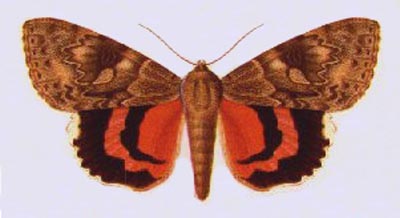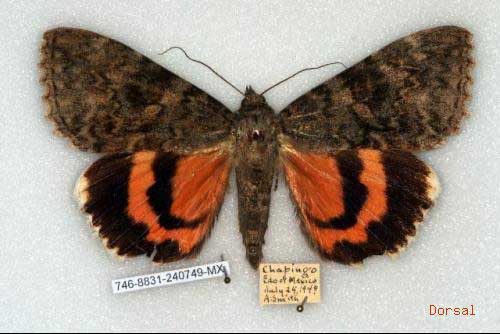Catocala electilis
Catocala electilis
kah-TOCK-uh-lahmmee-LECK-tih-lis
Walker, [1858]

Catocala electilis
composited from Hampson's British Museum Plate by Bill Oehlke.
This site has been created by
Bill Oehlke at oehlkew@islandtelecom.com
Comments, suggestions and/or additional information are welcomed by Bill.
| TAXONOMY:
Superfamily: Noctuoidea
Family: Noctuidae
Group: Noctuinina
Subfamily: Catocalinae
Genus: Catocala, Schrank, 1802
| |
MIDI MUSIC
"Moon River"
copyright C. Odenkirk
MIDI CITYON.OFF
<bgsound src="moon.mid" LOOP=FOREVER>
|
DISTRIBUTION:
Catocala electilis
(wingspan: mm), flies in Arizona and Mexico.
Catocala electilis has also been reported in Colorado and
Texas. I suspect it also flies in New Mexico.
The forewing is dark grey. The black pm line is thin but distinct; two upper teeth are not greatly produced.
The reniform spot is dark brown; the large, pork-chop shaped subreniform spot is a lighter brown
with its tail like extension to the pm line. Some brown shading in the subterminal area.
The hindwing is salmon (orange to red). The black median band, slightly outwardly produced at the cell,
is relatively thin and turns (almost right angle) toward and almost reaches the inner margin.
The hindwing fringes are white, heavily checked with black along the veins. There is often some slight "bleeding"
of salmon scaling just outside the black outer band.

Catocala electilis, Mexico, All Leps Bar Code of Life,
on my home computer only.

Catocala electilis, Mexico, All Leps Bar Code of Life,
on my home computer only.
FLIGHT TIMES AND PREFERRED FOOD PLANTS:
Catocala electilis are usually on the wing in .
The Catocala electilis caterpillar feeds on Populus fremonti.
ECLOSION:
Adults eclose from pupae at soil surface.
SCENTING AND MATING:
Catocala electilis females
emit an airbourne pheromone and males use their antennae to track the
scent plume.
EGGS, CATERPILLARS, COCOONS, AND PUPAE:
Eggs are deposited on
tree bark in the fall and hatch the following spring.
Larval Food Plants
Listed below are primary food plant(s) and alternate food plants.
It is hoped that this alphabetical listing followed by the common
name of the foodplant will prove useful. The list is not exhaustive,
although some species seem very host specific.
Experimenting with closely related foodplants is worthwhile.
Populus fremonti......
|
Western/Fremont cottonwood
|
Return to Main Index
This page is brought to you by Bill Oehlke and the
WLSS. Pages are on space rented from Bizland. If you would like to become a "Patron of the Sphingidae/Catocala Sites",
contact Bill.
Please send sightings/images to Bill. I will do my best to respond to requests for identification help.
Enjoy one of nature's wonderments: Live Saturniidae (Giant Silkmoth) cocoons.

|

To show appreciation for this site, click on the flashing
butterfly to the left, a link
to many worldwide insect sites. |




